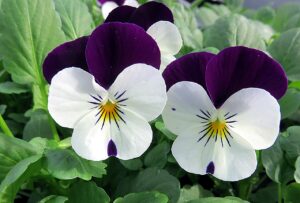
Violets – more than a pretty flower!
By Clive Larkman
Some plant families are small such as Ginkgoaceae which has only one genus and one species while others families, such as Asteraceae, have approximately 25 000 species. One of the largest families, Brassicaceae, consists almost entirely of edible plants and produces all those healthy green plants that most adults love and kids hate. Another interesting family that has approximately 1000 species, and is rarely thought of as producing edible plants, is Violaceae.
As a plant family, Violaceae has been around since the early 1800s and consists of around 25 genera, including the main one from which its name is derived – Viola. Of the remaining genera, two have around 400 species and the balance have only one or two species and are not common plants. Viola has around 650 species, the majority of which are temperate shrubs from the Northern Hemisphere. There are a few unusual genera from areas as divergent as Hawaii, Australia, and the alpine regions of South America.

It is hard to generalise across a range of plants as large as this but the majority of species have heart shaped leaves, flowers with five petals and bi-lateral symmetry, and in the majority of cases, are solitary flowers at the end of short stems. The majority also have very similar seed pods that when the dry will dehisce and spit seeds over a fair distance. Some cultivars can become weedy in open soil conditions like in nurseries and in new garden beds. In general, the flowers are in the purple range of colours, although there are many white and yellow forms with new species being classified/discovered on a regular basis.
The plants are usually herbaceous perennials, although there are a number of annuals, and also species, that are tender perennials which are treated as annuals in the colder climates. They are rarely over 15 cm tall and flower profusely in mid spring. Many forms have stoloniferous rhizomes that can make them slightly invasive although they do not compete well with most shrubs. They are moderate feeders, will tolerate some levels of dryness, and have very few pests. Some species and cultivars will tolerate more extremes such as the Australian species Viola hederacea which occurs widely across the southeast of the continent. It can live through extended dry and wet periods and will grow in full sun to part shade.
As a genus, Viola was first described by Carl Linnaeus in the 1750s which gives it some kudos as he is regarded as the authority on Viola. Since then, it has been moved across other genera and families and subdivided into sections. This is not surprising as it is an old genus with lots of written species and cultivars across the world being used in perfumery, as cut flowers,in garden designs and as an edible flower. There are books written about its place in the botanical hierarchy and botanists continually work on the genus and the broader family.
As a flowering plant, it is similar to lavender in that it occurs in poems, songs, paintings and jewelry going back centuries. However, it has also become a major landscaping plant as the genus includes the plants commonly used as bedding plants, for large floral displays and floral clocks. The genus includes pansies, violas, violets, violettas, Jolly Jump-ups, Heartsease and numerous other localised names. In the US there are several species giving rise to names like Common Blue violet, Wild Blue violet, Wood violet, and Meadow violet. It is the same in Europe with names like English violet, Fragrant violet, Florist’s violet, Common violet and Sweet violet.

Violet perfume is common, with most major fragrance companies having a violet perfume in their range. They use violet essential oil which is extracted from the leaves of Viola odorata by solvent extraction for commercial use. There are some companies that use steam extraction from the foliage and flowers harvested in mid spring.
It is not common knowledge but viola flowers and young leaves are edible. The young foliage can be used in salads and eaten raw, or lightly cooked as a mild tasting leafy green and is available all year. The flowers are excellent as decorations on salads, desserts, cocktails and on fancy modern cuisine. When used in dairy dishes they can add a mild fragrance as well as colour. The petals can be added to tisanes like lavender and chamomile for flavour and colour. The native Australian viola is as good as any European or US Viola for salads and garnishes.
Like so many plants that have been grown and cultivated for so long around the world there are multiple anecdotes of medicinal use. They are high in vitamin C and antioxidants although the volume of flowers needed for any real medical benefit is probably a bit too high. Heartsease or Johnny Jump-up (Viola tricolor) has been used for years to treat all sorts of respiratory issues, though none have been scientifically proven. In mythology, there is plenty written about its role in love and desire coming from the Greek, the Romans and the Druids. The name heartsease comes from its ability heal a broken heart by calming the wild emotions of lost love.
Next time you see that cute little pansy or violet flower think of how many peoples use them in daily life.
Main photo: Violas grow well in baskets (Image: Matthiasboeckel/Pixabay)
